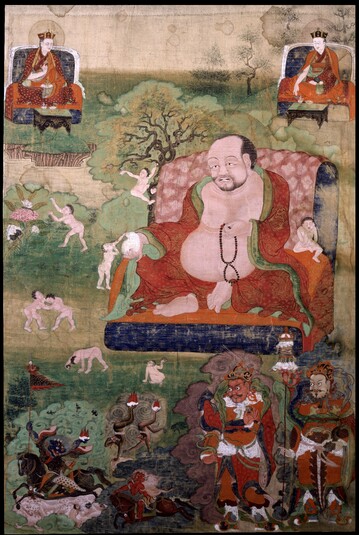
Item: Arhat/Sthavira (Buddhist Elder) - (Patron) Hvashang
| Origin Location | Eastern Tibet |
|---|---|
| Date Range | 1600 - 1699 |
| Lineages | Karma (Kagyu) |
| Material | Ground Mineral Pigment on Cotton |
| Collection | Robert and Lois Baylis |
| Painting School | Karma Gardri |
Classification: Person
Appearance: Arhat
Gender: Male
Hvashang (Tibetan: ha shang); the patron to the 16 arhats - principal students of Shakyamuni Buddha.

Gazing to the side, with a round face, unshaven and receding dark hair, portly in appearance, he holds in the right hand extended across the knee a persimmon fruit. In the left held at the heart is a mala - string of prayer beads. Without any ornamentation of gold or jewels he wears a long red cloak with green trim. In a relaxed posture with the right leg extended and the left drawn up, he sits atop a blue cushion seat with a broad backrest layered with various brocades. Eight small naked children sport and play at the front and sides.
At the top left is Shamar Yeshe Nyingpo (1631-1694) with the right hand in the mudra of blessing at the heart. The left placed in the lap holds a long-life vase. Wearing the orange and red robes of a monk, the head is adorned with the red crown of the Kamtsangpa sect of the Kagyu School. At the right side is the 11th Karmapa, Yeshe Dorje (1676-1702), with the right hand in the mudra of earth witness and the left in the lap holding a black begging bowl. Wearing orange and red robes, on the head is the famous black vajra crown of the Karmapas a gift from a grateful Chinese Emperor. Both are seated on cushion mats with small tables in front.
At the bottom left are the wrathful protectors Shing Kyong Father and Mother. The Father with a lion face is blue in colour. The right hand holds upraised a spear with a black and red pendant and the left outstretched holds a white skullcup filled with three triangular red torma (stylized food). Wearing a long black cloak and having a sword, quiver of arrows and a bow in a leopard skin case he rides on a black horse surrounded by light blue smoke; black birds soar above. Below to the right is the red Mother with long pink hair holding a trident in the right hand and eating a human heart with the left; riding atop a brown horse. Above, two monkeys standing each on one hand hold upraised with the feet red tormas in white skullcups.
At the right side stand two Direction Kings. The first is Virupaksha, red in colour, holding a writhing snake in the right hand and a small jewel held between the fingers in the left. Again at the right is Vaishravana, natural in colour, holding a victory banner in the right hand and a mongoose in the left. Both are attired in rich garments and jewelry.
Hva Shang, meaning a 'Chinese monk,' is thought to be an historic figure dispatched to India by a Tang Emperor to invite the buddha Shakyamuni to visit China. Since the Buddha had already passed away the invitation was then relayed to the 16 great arhats. Regarded as a monk he is also referred to as a patron because he carried the invitation. In the Tibetan tradition Hvashang has always been associated with the group known as the Sixteen Great Arhats . A full set of paintings would include the buddha Shakyamuni, two main students, the 16 arhats, the attendant Dharmatala and the Four Guardians of the Directions - Vaishravana, Virupaksha, Dritarashtra and Virudhaka. Neither of the common liturgies to the meditation practice popularized by the two Indian teachers Lord Atisha and Kashmiri pandita Shakya Shribhadra make reference to Hvashang. Therefore it is most probable that he is indeed a late iconographic concept introduced from China. (This painting belongs to the same set as #90001 and #90302).
Jeff Watt 9-99
Collection of Robert & Lois Baylis
Painting Set: Arhats: Single Main Figure
Arhat: Hvashang (Patron) Main Page
Painting Set: Arhat Set IX
Arhat: Hvashang Iconography
